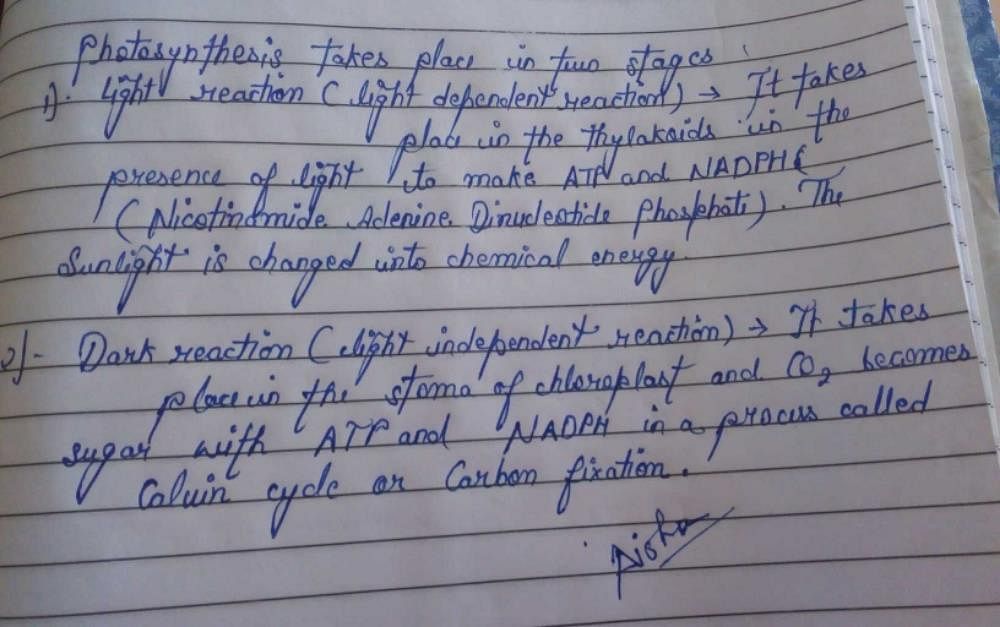Class 10 Exam > Class 10 Questions > Explain 2 stages of photosynthesis?
Start Learning for Free
Explain 2 stages of photosynthesis?
Community Answer
Explain 2 stages of photosynthesis?
Stage 1: Light-dependent reactions
During the light-dependent reactions, light energy is absorbed by pigments in the thylakoid membranes of chloroplasts. This energy is used to generate ATP and NADPH, which are essential for the second stage of photosynthesis. The light-dependent reactions can be broken down into several steps:
1. Light absorption: Pigments such as chlorophyll and carotenoids absorb light energy, which excites electrons and creates a high-energy state.
2. Electron transport: These high-energy electrons are passed along a series of electron carriers in the thylakoid membrane, releasing energy that is used to pump protons (H+) across the membrane.
3. ATP production: The buildup of protons creates a concentration gradient that drives the production of ATP through ATP synthase.
4. NADPH production: In a separate pathway, electrons from the electron transport chain are used to reduce NADP+ to NADPH.
Stage 2: Light-independent reactions
The light-independent reactions, also known as the Calvin cycle, take place in the stroma of chloroplasts. This stage does not require light energy directly but uses the ATP and NADPH produced in the first stage. The Calvin cycle can be broken down into several steps:
1. Carbon fixation: CO2 from the atmosphere is fixed into organic molecules using the enzyme Rubisco.
2. Reduction: These organic molecules are then reduced using ATP and NADPH to produce glyceraldehyde-3-phosphate (G3P).
3. Regeneration: Some of the G3P molecules are used to regenerate the starting material, ribulose bisphosphate (RuBP), while others are used to produce glucose or other sugars.
Overall, these two stages of photosynthesis work together to convert light energy into chemical energy that can be used by plants and other organisms.
During the light-dependent reactions, light energy is absorbed by pigments in the thylakoid membranes of chloroplasts. This energy is used to generate ATP and NADPH, which are essential for the second stage of photosynthesis. The light-dependent reactions can be broken down into several steps:
1. Light absorption: Pigments such as chlorophyll and carotenoids absorb light energy, which excites electrons and creates a high-energy state.
2. Electron transport: These high-energy electrons are passed along a series of electron carriers in the thylakoid membrane, releasing energy that is used to pump protons (H+) across the membrane.
3. ATP production: The buildup of protons creates a concentration gradient that drives the production of ATP through ATP synthase.
4. NADPH production: In a separate pathway, electrons from the electron transport chain are used to reduce NADP+ to NADPH.
Stage 2: Light-independent reactions
The light-independent reactions, also known as the Calvin cycle, take place in the stroma of chloroplasts. This stage does not require light energy directly but uses the ATP and NADPH produced in the first stage. The Calvin cycle can be broken down into several steps:
1. Carbon fixation: CO2 from the atmosphere is fixed into organic molecules using the enzyme Rubisco.
2. Reduction: These organic molecules are then reduced using ATP and NADPH to produce glyceraldehyde-3-phosphate (G3P).
3. Regeneration: Some of the G3P molecules are used to regenerate the starting material, ribulose bisphosphate (RuBP), while others are used to produce glucose or other sugars.
Overall, these two stages of photosynthesis work together to convert light energy into chemical energy that can be used by plants and other organisms.
Attention Class 10 Students!
To make sure you are not studying endlessly, EduRev has designed Class 10 study material, with Structured Courses, Videos, & Test Series. Plus get personalized analysis, doubt solving and improvement plans to achieve a great score in Class 10.

|
Explore Courses for Class 10 exam
|

|
Similar Class 10 Doubts
Explain 2 stages of photosynthesis?
Question Description
Explain 2 stages of photosynthesis? for Class 10 2024 is part of Class 10 preparation. The Question and answers have been prepared according to the Class 10 exam syllabus. Information about Explain 2 stages of photosynthesis? covers all topics & solutions for Class 10 2024 Exam. Find important definitions, questions, meanings, examples, exercises and tests below for Explain 2 stages of photosynthesis?.
Explain 2 stages of photosynthesis? for Class 10 2024 is part of Class 10 preparation. The Question and answers have been prepared according to the Class 10 exam syllabus. Information about Explain 2 stages of photosynthesis? covers all topics & solutions for Class 10 2024 Exam. Find important definitions, questions, meanings, examples, exercises and tests below for Explain 2 stages of photosynthesis?.
Solutions for Explain 2 stages of photosynthesis? in English & in Hindi are available as part of our courses for Class 10.
Download more important topics, notes, lectures and mock test series for Class 10 Exam by signing up for free.
Here you can find the meaning of Explain 2 stages of photosynthesis? defined & explained in the simplest way possible. Besides giving the explanation of
Explain 2 stages of photosynthesis?, a detailed solution for Explain 2 stages of photosynthesis? has been provided alongside types of Explain 2 stages of photosynthesis? theory, EduRev gives you an
ample number of questions to practice Explain 2 stages of photosynthesis? tests, examples and also practice Class 10 tests.

|
Explore Courses for Class 10 exam
|

|
Suggested Free Tests
Signup for Free!
Signup to see your scores go up within 7 days! Learn & Practice with 1000+ FREE Notes, Videos & Tests.


























